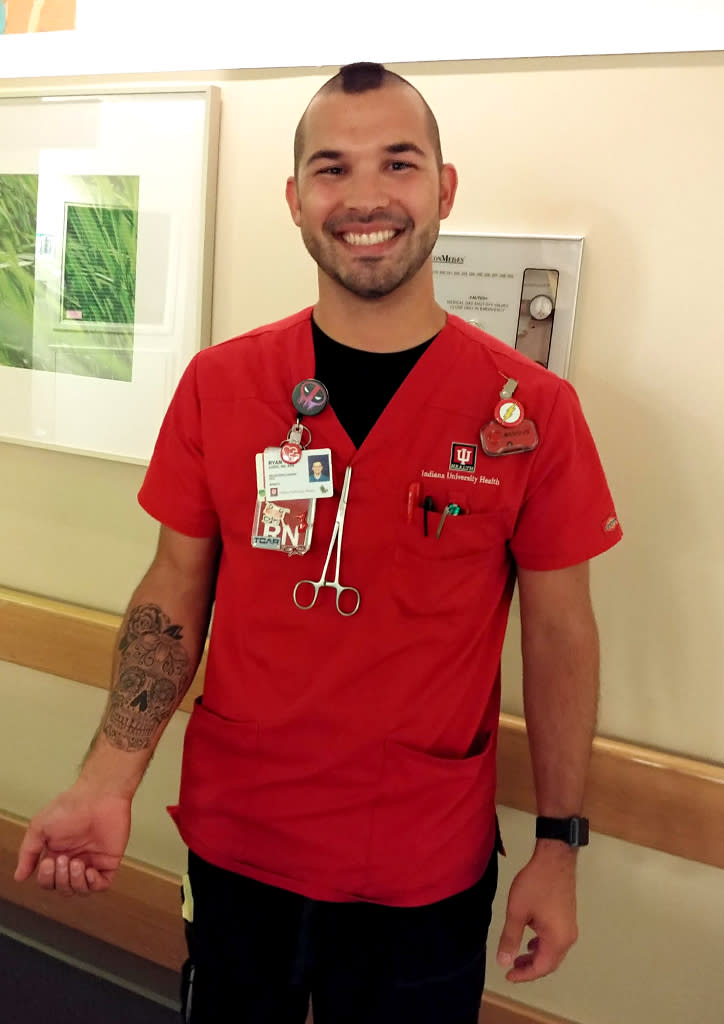Inked nurses and other tattooed professionals can finally roll up their sleeves at Indiana University

Somewhere between 29 percent and 46 percent of Americans have at least one tattoo, depending on which survey you’re reading. It stands to reason that the old stereotypes about who gets inked can’t hold true (if they ever did), which may be one of the reasons workplaces have been steadily dropping restrictions on having visible tattoos. In April, Indiana University Health System did so, and it looks like it’s been a win for the patients and 33,000 employees at its 16 hospitals.
“We have a significant number of millennials entering our workforce now, and we’ve really tried to hear their voices in so many ways and really seek to understand what’s most important to them,” Michelle Janney, chief nurse executive of IU Health, tells Yahoo Lifestyle. One of the things that was most important to them, and to nurses of other generations, it turns out, was being able to bring their “whole self” to work.
Though their white caps and shoes were long gone, the hospital staff previously had to adhere to a 50-page handbook, which dictated that their hair be only a natural color and that they keep their piercings and tattoos hidden.
“It was a very rules-driven culture,” Janney says about nursing. Now she says IU has moved toward trusting staff to look and act professionally, without giving them a long list of what they cannot do or show.
When deciding how to change these rules, the IU Health execs asked for patients’ opinions too, and the results they got challenged traditional assumptions about tattoos and “professionalism.”
“Patients assume that nurses are clinically competent, or they wouldn’t be there at the bedside, and so tattoos or lack thereof don’t define that for them,” Janney says. “What we didn’t ask but what we often hypothesize is that maybe many of our patients today have tattoos, and it’s a way of forging a relationship with [their caregiver], when you can identify with something that you see on someone’s body [and tell] what’s important to them.”
There’s a practical benefit to this policy change too. Since it went into effect in April, Janney says there’s been a drop in the vacancy rate and first-year turnover of nurses. Since IU Health has made other changes this year as well, she can’t say for sure that tattoos and hair color are the only reason this is the case, but she knows it’s part of it. Managers no longer have to turn down candidates for the tattoos they wouldn’t be able to cover up. Staff members sometimes stop Janney in the hallway to show off their tats, and one nurse immediately dyed her hair pink in honor of breast cancer awareness.
“We know through evidence that when you have a more highly engaged nursing workforce, you have better patient outcomes,” Janney says.
This is exactly what Nathan Madden, director of the activist network Support Tattoos and Piercings at Work, has been telling employers for years. Rather than criticizing companies that continue to ban visible tattoos and piercings in the workplace, his strategy is to show them how they might benefit by lifting the ban.
“It is so hard to find qualified, good workers now; when you shrink your hiring pool not on qualifications but on superficial reasons, you only wind up hurting your own company,” Madden tells Yahoo Lifestyle.
In his work, he has found that veterinary offices are one of the most stringent workplaces when it comes to tattoos. Resorts and police forces also restrict employees from showing any body art.
Madden argues allowing employees to express themselves fully will improve morale at work.
“I see companies constantly baffled, like, ‘How come our staff doesn’t value our company culture?'” he says. “When over 75 percent of tattoos have to do with your family memories or values, and you’re telling your staff to cover up their memories, their family, their values, [it’s like saying,] ‘We don’t care about that.'”
According to a 2016 Harris Poll, only 27 percent of people with tattoos said getting inked made them feel more rebellious. The same poll found that a majority of respondents would be comfortable seeing a person with a tattoo in positions such as judge, presidential candidate, doctor, banker, and primary school teacher.
“We are currently facing five generations in the workplace, and we cannot expect that what has worked for one will also work for the other,” personal branding expert Sylvie di Giusto tells Yahoo.
While standards are changing, businesses still have the right to control how employees, particularly those who deal directly with customers, represent them.
“It’s the employees’ choice if they are able and willing to work according to these regulations,” Di Giusto says. For this reason, she counsels clients and others to think strategically about their future goals when deciding whether to get a tattoo that can’t easily be hidden.
“Where would you like to be when everything goes ‘according to your plan’?” she asks. “And from there, I’d work my way backward and ask myself, ‘Will these decisions hold me back from reaching this goal?'”
At the same time, she agrees with Madden that employees’ appearance is far from the most relevant factor in their performance.
“As an organization, I’d be less concerned about a visible tattoo than about the fact that at any given moment, employees can tweet, post, share something online that could immediately ruin the company’s reputation,” Di Giusto says. “One inappropriate tweet can reach an audience a million times bigger than any tattoo ever can.”
Read more from Yahoo Lifestyle:
How Miss USA contestants answered #MeToo, Boy Scouts, and other serious questions
‘You can be unhappy with it or thank God for what you have’: Curvy influencer shares key to success
Follow us on Instagram, Facebook, and Twitter for nonstop inspiration delivered fresh to your feed, every day.

